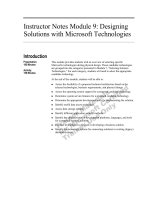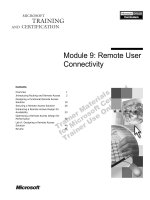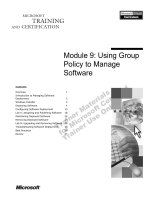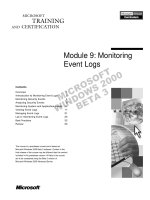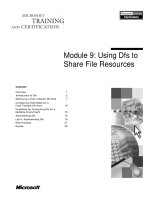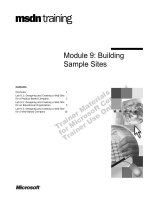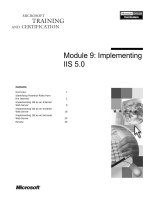CCNA 1 Network Basics - Module 9 TCP/IP Protocol and IP Addressing docx
Bạn đang xem bản rút gọn của tài liệu. Xem và tải ngay bản đầy đủ của tài liệu tại đây (318.49 KB, 30 trang )
1
Version 3.0
Module 9
TCP/IP Protocol and
IP Addressing
2
Version 3.0
History of TCP/IP
•
The U.S. Department of Defense (DoD) created the TCP/IP
reference model because it wanted a network that could survive
any conditions.
•
The TCP/IP model has since become the standard on which the
Internet is based.
•
In 1992 the standardization of a new generation of IP, often
called IPng, was supported by the Internet Engineering Task
Force (IETF). IPng is now known as IPv6.
3
Version 3.0
The TCP/IP model has four layers: The Application layer,
Transport layer, Internet layer, and Network Access layer.
TCP/IP Model
4
Version 3.0
Application Layer
•
The application layer of the TCP/IP model handles
high-level protocols, issues of representation,
encoding, and dialog control.
•
The Application layer of the TCP/IP model has
protocols to support file transfer, e-mail, and remote
login, and many other applications.
5
Version 3.0
Application Layer
6
Version 3.0
Application Layer
•
File Transfer Protocol (FTP)
•
Trivial File Transfer Protocol (TFTP) – TFTP is a connectionless
service that uses the User Datagram Protocol (UDP).
•
Network File System (NFS) – NFS is a distributed file system protocol
suite developed by Sun Microsystems that allows file access to a remote
storage device such as a hard disk across a network.
•
Simple Mail Transfer Protocol (SMTP) – SMTP administers the
transmission of e-mail over computer networks.
•
Terminal emulation (Telnet) – Telnet provides the capability to remotely
access another computer.
•
Simple Network Management Protocol (SNMP) – SNMP is a protocol
that provides a way to monitor and control network devices, and to
manage configurations, statistics collection, performance, and security.
•
Domain Name System (DNS) – DNS is a system used on the Internet for
translating names of domains and their publicly advertised network nodes
into IP addresses.
7
Version 3.0
Transport Layer
•
The transport layer provides transport services from the source
host to the destination host.
•
The transport layer constitutes a logical connection between the
endpoints of the network, the sending host and the receiving
host.
•
End-to-end control is the primary duty of the transport layer
when using TCP.
8
Version 3.0
Transport Layer
9
Version 3.0
Transport Layer
Transport services include all the following services:
•
TCP and UDP
–
Segmenting upper-layer application data
–
Sending segments from one end device to another end
device
•
TCP only
–
Establishing end-to-end operations
–
Flow control provided by sliding windows
–
Reliability provided by sequence numbers and
acknowledgments
10
Version 3.0
Internet Layer
•
The purpose of the Internet layer is to select the best path
through the network for packets to travel.
•
The main protocol that functions at this layer is the
Internet Protocol (IP).
11
Version 3.0
Internet Layer
The following protocols operate at the TCP/IP Internet layer:
•
IP provides connectionless, best-effort delivery routing of
packets. IP is not concerned with the content of the
packets but looks for a path to the destination.
•
Internet Control Message Protocol (ICMP) provides
control and messaging capabilities.
•
Address Resolution Protocol (ARP) determines the data
link layer address, MAC address, for known IP addresses.
•
Reverse Address Resolution Protocol (RARP) determines
IP addresses when the MAC address is known.
12
Version 3.0
Network Access Layer
•
The network access layer is also called the host-to-
network layer.
•
It includes the LAN and WAN technology details
13
Version 3.0
Comparing OSI and TCP/IP
Both have application layers,
though they include very different
services
TCP/IP combines the presentation
and session layer into its
application layer Combines the
Data Link and Physical layer into
the Network Access Layer
Both have comparable transport
and network layers
TCP/IP appears simpler because it
has fewer layers
Packet-switched, not circuit-
switched, technology is assumed
TCP/IP transport layer using UDP
does not always guarantee reliable
delivery of packets as the transport
layer in the OSI model does
14
Version 3.0
Comparing OSI and TCP/IP
The OSI model is used as a guide for
understanding the communication process.
15
Version 3.0
Addressing
•
Each computer in a TCP/IP network must be given a
unique identifier, or IP address.
–
This address, operates at Layer 3
•
All computers also have a unique physical address, known
as a MAC address. These are assigned by the
manufacturer of the network interface card.
–
MAC addresses operate at Layer 2 of the OSI model.
16
Version 3.0
IPv4 Addresses
•
An IP address is a 32-bit sequence of 1s and 0s
•
Every IP address has two parts
–
The network portion
–
The host portion
•
An IP address is an hierarchical address
•
IP addresses are divided into classes to define the large,
medium, and small networks
–
Class A
–
Class B
–
Class C
17
Version 3.0
IP Classes of Addresses
18
Version 3.0
19
Version 3.0
Reserved IP Addresses
•
Certain host addresses
are reserved and cannot
be assigned to devices on
a network
–
Network address – Used
to identify the network itself
–
Broadcast address – Used
for broadcasting packets to
all the devices on a network
20
Version 3.0
Private Addresses
•
With the rapid growth of the Internet, public IP addresses
were beginning to run out.
•
Solutions to expand the number of IP addresses available
for public use include:
–
classless interdomain routing (CIDR)
–
IPv6
–
Private IP addresses
21
Version 3.0
Private Addresses
•
Internet requires translation of the private addresses to
public addresses.
•
This translation process is referred to as Network Address
Translation (NAT)
22
Version 3.0
Subnetting
•
To create a subnet address, a network administrator
borrows bits from the host field and designates them as
the subnet field
•
The minimum number of bits that can be borrowed is two
•
The maximum number of bits that can be borrowed can be
any number that leaves at least two bits remaining, for the
host number
23
Version 3.0
IPv4 and IPv6
•
IPv6 uses 128 bits rather
than the 32 bits
•
Provides 640 sextrillion
addresses
•
IPv6 addresses are 128
bits long, written in
hexadecimal form, and
separated by colons. IPv6
fields are 16 bits long.
24
Version 3.0
Assigning IP Addresses
•
Network administrators use two methods to
assign IP addresses.
–
Static
•
Administratively assigned
–
Dynamic
•
Automatically assigned
25
Version 3.0
Static IP Addresses
•
Static assignment works best on small, infrequently
changing networks
•
Good recordkeeping is critical to prevent problems which
occur with duplicate IP addresses
•
Servers should be assigned a static IP address so
workstations and other devices will always know how to
access needed services
•
Other devices that should be assigned static IP addresses
are network printers, application servers, and routers

